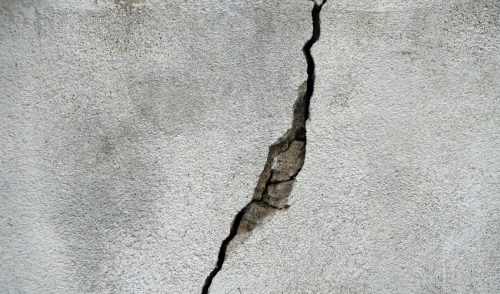{article.name}
Social Media Links
DIY Tips for Repairing a Cracked Basement Wall

- Share this:
- Share on Facebook
- Pin on Pinterest
- Tweet on Twitter
If you find excessive dampness your basement, the likely culprit could be a crack in your basement wall. When you consider that your basement walls hold up your entire house, then knowing that there are cracks present can sound a little intimidating. The fact is that cracks aren’t that uncommon. They’ll most likely just require a little DIY know-how and a simple patch. Small cracks don’t usually affect the structural integrity of your home, but if left untouched they can allow water, insects or even radon gas to enter your basement. Larger cracks of an inch or greater indicate a more serious issue and should be looked at by a professional.
The two most common techniques for repairing basement wall cracks involve using either hydraulic cement or epoxy. With either method, proper preparation of the area is the same. The crack must be clean and dry. Using a chisel or screwdriver, remove any loose or damaged material from the crack, and then sweep the area with a stiff-bristled brush.
If using an epoxy filler, make sure the area is completely dry. If there is moisture present, you can use a blow dryer, but will need to wait about a half-hour afterwards to make sure moisture doesn’t return. If it does, you have to wait for a time when the crack can dry on its own. Once dry, you can then mix the two parts of the epoxy together and apply it to the crack until the surface is even with the rest of the concrete. It is recommended to wear latex gloves during this process, since epoxy is very difficult to remove once it has cured.
If using hydraulic cement, you can mix it by hand or purchase it already premixed. Once ready to apply the cement, spray the area with water to ensure a good bond with the existing cement. Pack it into the crack as best as possible. Hydraulic cement expands as it cures, and in doing so, the crack will be effectively sealed.
For deeper cracks, there are concrete repair kits available --most of which include a two-part epoxy crack filler, tubes of liquid concrete repair (LCR) and injection ports that are used for getting the LCR deep into the damaged area. The ports are tapped into the crack, followed by the two-part epoxy which is used to fill the area around them. Once the epoxy has cured, the LCR is injected into the ports, deep into the wall. The LCR then expands, completely sealing the crack. This is an effective way of repairing a deep crack from inside. The LCR may go all the way through the wall to the outside, but in many cases, this will eliminate the cost and effort of digging down from above ground.
If you find any cracks in your basement wall and have any questions, stop in and we’ll be happy to answer them. We’ll supply you with the tools, materials and advice you’ll need to finish your repair as quickly and safely as possible.
Sign up for our Email List
Stay updated with all our latest posts, products and offers! Just enter your information below.


Comments